
- Home
- Travel Packages
- Top Destination
-
Travel Attraction
By Category
Top Attraction

- Travel Agents
- Car Rentals
- Hotels
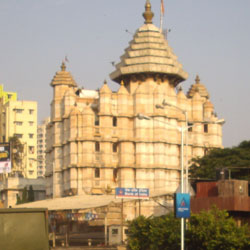
About The Siddhivinayak Temple The Siddhivinayak Temple is a famous Hindu temple located in Mumbai, Maharashtra. Dedicated to Lord Ganesha, it is one of the most visited and revered temples in India. The temple is known for fulfilling the wishes of its devotees and is believed to bring good luck and prosperity to those who worship there. Architecture of Siddhivinayak Temple The Siddhivinayak Temple is built in the traditional Indian architectural style with a dome-shaped roof and intricately carved pillars. The main sanctum sanctorum houses the idol of Lord Ganesha, which is adorned with gold and precious stones. The temple complex also includes shrines dedicated to other Hindu deities like Lord Shiva and Goddess Parvati. History The history of the Siddhivinayak Temple dates back to the 18th century when a childless woman named Deubai Patil commissioned the construction of the temple as a dedication to Lord Ganesha. Over the years, the temple gained popularity among devotees from all walks of life, who come to seek the blessings of Lord Ganesha for various reasons. Best Time To Visit The Siddhivinayak Temple is open to devotees all year round, but the best time to visit is during the festivals of Ganesh Chaturthi and Maghi Ganesh Jayanti when the temple is beautifully decorated and attracts a large number of worshippers. The temple is also less crowded during weekdays, making it a peaceful place for prayer and meditation. How To Reach The Siddhivinayak Temple is located in Prabhadevi, a suburb of Mumbai. It is easily accessible by road, rail, and public transport. The nearest railway station is Dadar, which is just a short walk away from the temple. Visitors can also take a taxi or bus to reach the temple from any part of Mumbai. Significance Of The Siddhivinayak Temple The Siddhivinayak Temple holds great significance for devotees who believe that worshipping Lord Ganesha at this temple can help them overcome obstacles and attain success in their endeavors. Many people offer prayers and perform rituals at the temple to seek blessings for health, wealth, and happiness. The temple is also known for its charitable activities and social initiatives, making it a symbol of faith and benevolence. In conclusion, the Siddhivinayak Temple is not just a place of worship but a spiritual sanctuary where devotees can connect with the divine and find solace in times of need. Its rich history, beautiful architecture, and sacred atmosphere make it a must-visit destination for anyone seeking blessings and inner peace.
Explore More
About The Mahalaxmi Temple The Mahalaxmi Temple, located in Mumbai, is a sacred Hindu temple dedicated to the goddess Mahalaxmi. The temple is one of the oldest temples in the city and holds immense religious significance among devotees. The goddess Mahalaxmi is worshipped here as the presiding deity, symbolizing wealth, prosperity, and well-being. Architecture of Mahalaxmi Temple The Mahalaxmi Temple showcases traditional Hindu temple architecture with intricate carvings and sculptures adorning its walls and pillars. The main sanctum sanctorum houses the idol of Mahalaxmi adorned with jewels and flowers. The temple's entrance is marked by a tall tower, known as a shikara, which is a prominent feature of South Indian temple architecture. History The Mahalaxmi Temple has a rich history dating back several centuries. It is believed that the temple was built during the reign of the Maratha Empire in the 18th century. Over the years, the temple has undergone renovations and expansions, but its spiritual essence and significance have remained intact. The temple attracts thousands of devotees every year who come to seek the blessings of the goddess. Best Time To Visit The best time to visit the Mahalaxmi Temple is during the festival of Navratri, which is celebrated with great enthusiasm and fervor. Navratri is a nine-day festival dedicated to the worship of the goddess Durga, of which Mahalaxmi is considered an incarnation. The temple is beautifully decorated during this time, and devotees flock to offer their prayers and seek blessings. How To Reach The Mahalaxmi Temple is centrally located in Mumbai and is easily accessible by both public and private transportation. The nearest railway station is Mahalaxmi Station, which is just a short walk away from the temple. Additionally, local buses and taxis are readily available for those who prefer to travel by road. The temple's convenient location makes it a popular destination for both locals and tourists. Significance Of The Mahalaxmi Temple The Mahalaxmi Temple holds immense significance for devotees who believe in the goddess's power to bring wealth, prosperity, and happiness into their lives. Many people visit the temple to seek blessings for success in their endeavors, good health, and overall well-being. The temple is also known for its charitable activities and social initiatives, making it a symbol of faith, devotion, and community service. In conclusion, the Mahalaxmi Temple in Mumbai stands as a testament to the enduring faith and devotion of its worshippers. With its rich history, beautiful architecture, and spiritual significance, the temple continues to attract devotees from all walks of life who come to seek solace, blessings, and divine grace from the goddess Mahalaxmi. Whether you are a devout follower or simply a curious visitor, a visit to the Mahalaxmi Temple is sure to leave you with a sense of peace, serenity, and spiritual fulfillment.
Explore More
About The Iskcon Temple The Iskcon Temple in Mumbai, officially known as the Sri Sri Radha Rasabihari Ji Temple, is a spiritual retreat located in Juhu. This temple is a part of the International Society for Krishna Consciousness (Iskcon) and serves as a center for spiritual enlightenment, cultural activities, and community service. Architecture Of Iskcon Temple The Iskcon Temple in Mumbai is known for its breathtaking architecture. The main structure of the temple is built in the traditional Indian style of architecture, with intricate carvings and vibrant colors. The temple complex also includes beautifully landscaped gardens, meditation halls, and a vegetarian restaurant. History The Iskcon Temple in Mumbai was established in 1978 by the followers of A.C. Bhaktivedanta Swami Prabhupada, the founder of the Iskcon movement. Since its inception, the temple has been a popular destination for devotees and tourists alike, attracting visitors from all over the world who come to seek spiritual solace and participate in the various cultural events held at the temple. Best Time To Visit The best time to visit the Iskcon Temple in Mumbai is during the festivals of Janmashtami and Diwali when the temple is beautifully decorated and spiritual celebrations are held. The temple is also a serene retreat for those seeking inner peace and tranquility throughout the year. How To Reach The Iskcon Temple in Mumbai is easily accessible by both public and private transportation. The nearest railway station is Andheri, which is well-connected to the rest of the city. Visitors can also take a bus or taxi to reach the temple from any part of Mumbai. Significance Of The Iskcon Temple The Iskcon Temple in Mumbai holds great significance for followers of the Iskcon movement as a place of worship, meditation, and spiritual learning. The temple is dedicated to Lord Krishna and Radha, and serves as a center for spreading the teachings of devotion and love for God. Visitors to the temple can participate in prayers, chanting, and other spiritual activities that help in connecting with their inner selves and finding peace and harmony in their lives.
Explore More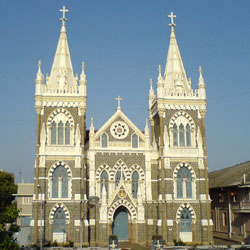
About Mount Mary Church, Mumbai Mount Mary Church, located in Bandra, Mumbai, is one of the most popular Roman Catholic churches in India. It is dedicated to Mother Mary and is also known as the 'Basilica of Our Lady of the Mount'. The church is known for its beautiful architecture, peaceful ambiance, and panoramic views of the Arabian Sea. Visiting Hours The church is open to visitors every day from 6:00 AM to 12:00 PM and 4:00 PM to 9:00 PM. History Mount Mary Church was originally built in 1640 by the Portuguese Jesuits and later rebuilt in 1761. It has since undergone several renovations and expansions, with the current structure dating back to the 1900s. Church Services and Events The church holds regular Mass services throughout the week, with special services on Sundays and religious holidays. It also hosts annual events such as the Feast of Mount Mary in September, which draws thousands of pilgrims and tourists. Architectural Facts The church's Gothic Revival style architecture features tall spires, intricate stained glass windows, and ornate decorations. The interior is adorned with religious paintings, statues, and a stunning altar. Accessibility and Directions Mount Mary Church is easily accessible by car or public transport. The nearest train station is Bandra, and there are also buses and taxis available. Parking is limited, so it is advisable to use public transport. The church is wheelchair accessible. Visitor's Information There is no entry fee to visit the church, but donations are welcomed. Guides are available on site to provide information about the history and significance of the church. Nearby attractions include Bandstand Promenade, Bandra Fort, and shopping markets. Visitors are advised to dress modestly when visiting the church.
Explore More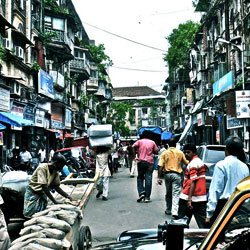
North of Crawford Market, are the narrow lanes of Kalbadevi a predominantly Muslim area hemmed in by laundry-draped chawls, which is home to a seething mass of people. It is a complete contrast to South Mumbai cleanliness and orderliness and is a different world in itself giving insight into the lives of people living in such chawls. No visit to Mumbai is complete without a foray into the bazaars of Kalbadevi, north of Crawford Market. It is a perfect foil to the relative space, orderliness and modernity of South Mumbai.
Explore More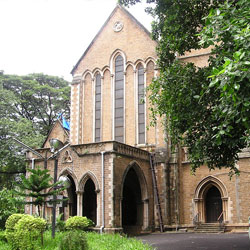
About Afghan Church, Mumbai The Afghan Church, located in Mumbai, India, is a historical and iconic church that serves as a place of worship for the Afghan Christian community in the city. The church is known for its beautiful architecture and rich history, making it a popular destination for tourists and locals alike. Visiting Hours The Afghan Church is open to visitors on weekdays from 9:00 AM to 5:00 PM. It is also open on weekends, but the hours may vary, so it is recommended to check ahead of time. History The Afghan Church was built in the 19th century to commemorate the British and Indian soldiers who lost their lives in the First Afghan War. The church was consecrated in 1858 and has since become a symbol of peace and remembrance. Church Services and Events The Afghan Church holds regular services for the Afghan Christian community, as well as special events and festivals throughout the year. The timings for these services and events may vary, so visitors are advised to check ahead of time. Architectural Facts The Afghan Church is known for its Gothic Revival architecture, with its towering spires and intricate carvings. The church is also home to beautiful stained glass windows and a majestic altar, making it a sight to behold for visitors. Accessibility and Directions The Afghan Church is easily accessible by car or public transport. There is parking available near the church for visitors who are driving. The church is also wheelchair accessible, making it inclusive for all visitors. Visitor's Information There is no entry fee to visit the Afghan Church, and guides are available for those who wish to learn more about the church's history and significance. Nearby attractions to visit around the church include the Gateway of India and Colaba Causeway. There is no specific dress code for visitors, but it is recommended to dress modestly out of respect for the church.
Explore More
About The Mumbadevi Temple The Mumbadevi Temple is a Hindu temple located in Mumbai, Maharashtra. It is dedicated to Mumbadevi, who is believed to be the city's patron goddess. The temple is one of the oldest in Mumbai and holds great religious significance among the locals. Architecture of Mumbadevi Temple The Mumbadevi Temple is built in the traditional Hindu architectural style. The temple's exterior is adorned with intricate carvings and sculptures depicting various Hindu deities. The sanctum sanctorum houses the idol of Mumbadevi, which is made of black stone and adorned with jewels. History The history of the Mumbadevi Temple dates back to the 16th century when the city of Mumbai was known as Bombay. It is said that the temple was originally located at Bori Bunder, which was one of the seven islands that formed Mumbai. Over the years, as the city expanded, the temple was relocated to its current location in Zaveri Bazaar. Best Time To Visit The Mumbadevi Temple can be visited throughout the year, but the best time to visit is during the Navratri festival, which is dedicated to the goddess Durga. The temple is beautifully decorated during this time, and devotees from all over the city come to seek the blessings of Mumbadevi. How To Reach The Mumbadevi Temple is located in the heart of Mumbai, making it easily accessible by both public and private transportation. The nearest railway station is Chhatrapati Shivaji Terminus, which is just a short distance away from the temple. Visitors can also take a bus or taxi to reach the temple. Significance Of The Mumbadevi Temple The Mumbadevi Temple holds great significance among the locals of Mumbai. It is believed that Mumbadevi is the guardian deity of the city and protects its residents from harm. Devotees visit the temple to seek blessings for prosperity, protection, and success in various endeavors. The temple also attracts tourists who are interested in exploring the religious and cultural heritage of Mumbai. In conclusion, the Mumbadevi Temple is a sacred place of worship that symbolizes the rich history and tradition of Mumbai. It is a must-visit destination for anyone looking to experience the spiritual essence of the city and seek the blessings of the goddess Mumbadevi.
Explore More
Nestled in an inner fold of the Sahyadri hills, 100 kms away from Aurangabad are the 30 rock-cut caves of Ajanta, famous for its cave painting or frescoes of many colors. They contain numerous images of Buddha. Caves 1,2,16 and 17 have the best-preserved paintings. The magnificient depictions of the bodhisattvas Avalokitesvara and Padmapaniin are particularly well known. The Ajanta Caves are a World Heritage site cut from the volcanic lava of the Deccan in the forest ravines of the Sahyadri Hills. They are set in beautiful sylvan surroundings, providing a unique combination of architecture, sculpture and paintings.
Explore More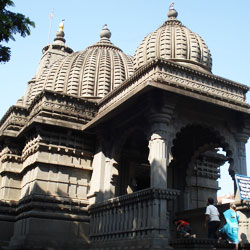
About The Kala Ram Mandir Temple The Kala Ram Mandir Temple, located in Nashik, Maharashtra, is a popular Hindu temple dedicated to Lord Rama. The temple is known for its beautiful architecture, serene surroundings, and religious significance. Devotees from all over the country visit this temple to seek blessings and offer prayers to Lord Rama. Architecture of Kala Ram Mandir Temple The Kala Ram Mandir Temple boasts of exquisite architecture that reflects traditional Hindu temple design. The temple is built using white marble and features intricate carvings and sculptures depicting various scenes from Hindu mythology. The main sanctum sanctorum houses the idol of Lord Rama along with Goddess Sita and Lord Lakshmana. The temple complex also has smaller shrines dedicated to other Hindu deities. History The Kala Ram Mandir Temple has a rich history that dates back several centuries. It is believed that the temple was constructed by a local king to honor Lord Rama. Over the years, the temple has undergone several renovations and extensions to enhance its beauty and religious significance. Today, the temple stands as a symbol of devotion and faith for millions of devotees. Best Time To Visit The best time to visit the Kala Ram Mandir Temple is during the Hindu festivals of Ram Navami and Diwali when the temple is adorned with lights and decorations. These festivals attract a large number of devotees who come to offer prayers and seek blessings from Lord Rama. Additionally, the winter months from November to February are also a good time to visit the temple due to the pleasant weather. How To Reach The Kala Ram Mandir Temple is located in Nashik, Maharashtra, making it easily accessible by road, rail, and air. The nearest airport is the Ozar Airport, which is about 30 kilometers away from the temple. The Nashik Road Railway Station is the nearest railhead, located around 10 kilometers from the temple. Visitors can also reach the temple by taking a bus or hiring a taxi from Nashik city. Significance Of The Kala Ram Mandir Temple The Kala Ram Mandir Temple holds immense religious significance for devotees of Lord Rama. It is believed that offering prayers at this temple can fulfill one's wishes and bring peace and prosperity into their lives. The temple is also known for its spiritual aura and serene atmosphere, which helps devotees connect with the divine. Many people visit the temple to seek blessings for their well-being, success, and happiness. In conclusion, the Kala Ram Mandir Temple in Nashik is a sacred place of worship that attracts devotees from all walks of life. With its beautiful architecture, rich history, and religious significance, the temple stands as a symbol of devotion and faith. Whether you are a devout follower of Lord Rama or simply seeking spiritual solace, a visit to this temple is sure to leave you feeling blessed and rejuvenated.
Explore More
About The Ghrishneshwar Temple The Ghrishneshwar Temple, also known as the Ghrneshwar Jyotirlinga Temple, is a Hindu temple dedicated to Lord Shiva located in Aurangabad, Maharashtra. It is one of the 12 Jyotirlinga shrines mentioned in the Shiva Purana and is considered to be one of the holiest sites for Shiva devotees. The temple is a magnificent example of ancient Hindu architecture and attracts a large number of pilgrims and tourists each year. Architecture of Ghrishneshwar Temple The Ghrishneshwar Temple is built in the Hemadpanthi style of architecture, which is characterized by intricately carved stone pillars, walls, and ceilings. The temple has a five-tiered shikara (spire) that is adorned with sculptures of various Hindu deities. The sanctum sanctorum houses the lingam (symbol of Lord Shiva) and is surrounded by beautifully carved pillars and statues. The temple complex also includes a large courtyard, a water tank, and several smaller shrines dedicated to other gods and goddesses. History The Ghrishneshwar Temple dates back to the 18th century and is believed to have been constructed by Ahilyabai Holkar, the queen of the Malwa kingdom. According to legend, the temple was built at the site where Lord Shiva appeared in the form of a jyotirlinga (pillar of light) to fulfill the prayers of a devout brahmin named Ghushmaar. The temple has undergone several renovations and restorations over the years, but its original charm and spiritual significance have remained intact. Best Time To Visit The best time to visit the Ghrishneshwar Temple is during the winter months from November to February when the weather is pleasant and conducive for sightseeing. The temple also experiences a surge in visitors during the Mahashivratri festival, which is celebrated with great fervor and devotion by devotees from all over the country. It is advisable to avoid visiting the temple during the monsoon season as the region experiences heavy rainfall and the temple may be crowded with pilgrims. How To Reach The Ghrishneshwar Temple is located in the village of Verul, approximately 30 kilometers from Aurangabad city in Maharashtra. The nearest airport is Aurangabad Airport, which is well-connected to major cities in India. The temple can be easily reached by road from Aurangabad city via local buses, taxis, and auto-rickshaws. It is also possible to hire a private car or take a guided tour to visit the temple and other nearby attractions in the region. Significance Of The Ghrishneshwar Temple The Ghrishneshwar Temple is of great significance to Shiva devotees as it is believed to be the abode of one of the 12 Jyotirlingas, which are considered to be the most sacred shrines dedicated to Lord Shiva. Pilgrims visit the temple to seek blessings, offer prayers, and perform rituals to fulfill their wishes and receive divine grace. The temple also holds cultural and historical importance as it is a fine example of ancient Hindu architecture and craftsmanship. In conclusion, the Ghrishneshwar Temple in Aurangabad is a place of immense spiritual and cultural value, attracting visitors from all walks of life. Whether you are a devout pilgrim seeking blessings or a curious traveler interested in exploring the rich heritage of India, a visit to this sacred site is sure to leave a lasting impression on your heart and mind.
Explore More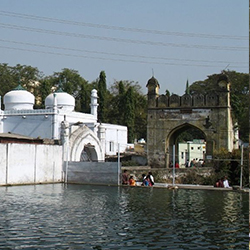
Panchakki And Baba Shah Musafir Temple
Located close to Bibi ka Maqbara in Daulatdabad, Panchakki is a water mill complex consisting of a court, a madrasa, the house of a minister, a mosque, houses dedicated to females and a Sarai. The mill gets it names from the grinding mill used to crush grains for the pilgrims. Enclosed in varieties of blue and shades of green, Panchakki is a perfect picnic spot and a much-frequented attraction in Daulatabad. A personification of medieval Indian architecture, Panchakki alias Nehar-e-Panchakki was erected in 1744 in the memory of Hazrat Baba Shah Musafir. He was a Sufi saint and spiritual guide of Aurangzeb. The amazing Panchakki is situated in the heart of the city, meaning the chakki or grinder run by water. This panchakki was set up in the 17th century for the pilgrims and followers of saints as well as for hordes of the garrison. There is a pond on one side and on the other side is this grinding mill. There is an underground water stream six km away from Panchakki, which is a stream of Harsul River. It is known to be the source of steady water supply to this construction and is transported through earthen pipes. You can only envisage the pure brilliance and farsightedness of the creation plan of this marvel. Dargah Baba Shah Musafir is a 17th-century memorial built by Emperor Aurangzeb in the honour of Baba Shah Musafir who was the spiritual teacher of the emperor. The memorial complex has a tombstone of Baba Shah Musafir temple or a mosque, a beautiful garden and an enticing fountain. The ambience created in the beautiful complex is remarkably peaceful and inviting. Special Attraction: What is noteworthy is that even though the purpose of the building Panchakki was sheer utility, the beauty of it is not compromised at least. The peaceful silver waters of the pool act like the sky's glass and the mild, rhythmic currents hypnotise the spectator. One can find many attractive places to visit like Shahi Eidgah and Navkhanda Palace. History of Panchakki And Baba Shah Musafir Temple: This spellbinding structure was built with great engineering and floor plans that were way ahead of their time. At the time of structure, Panchakki was a real whizz for the whole nation. Based purely on cutting-edge physics and technical principles, its key purpose was to generate electricity from an adjacent flowing spring and grind grains for the use of pilgrims, saints, military troops and devotees that came to Daulatabad in the 17th century. Baba Shah Musafir Dargah, an extensive garden featuring amazingly beautiful vestiges. It is primarily known for the fact that from here one can see the view Kham River and the cenotaph of Baba Shah Musafir. Architecture of Panchakki And Baba Shah Musafir Temple: Panchakki and the maqbara in the complex were erected by Turktaz Khan, a nominated noble on the staff of King Nizam-ul-Mulk Asaf Jah. The comprehensive and deep tank that greets you in front of the Baba Shah Musafir Temple, Daulatabad and beautiful flowering fountains were added about twenty years later by Jamil Beg Khan. Best Time to Visit Panchakki And Baba Shah Musafir Temple: The best time to visit Panchakki and Baba Shah Musafir Temple, Daulatabad is from November to March. The weather is moderately pleasant around this time. But if you want to see this Panchakki in its active phase, then monsoon is the best time to visit. Winters are somewhat chilling, but people usually enjoy this kind of weather while touring. How to Reach Panchakki And Baba Shah Musafir Temple Daulatabad? Daulatabad is one of the most popular places to visit in Maharashtra. State buses and private tour vehicles regularly ply to the city, and Panchakki is only 1 km away from the central city. The nearest bus stop to Panchakki is Ghati bus stop at a mere distance of 350 meters. Aurangabad Railway Station is the closest railhead, at a distance of 4 km, which is approximately a 12 min drive. Tourists can hire a private car, an auto rickshaw or use public transportation like city buses to reach there. The drive is an approximate 4-5 km from Central Bus Stand and 8-10 km from Railway Station. Interesting Facts and Trivia about Panchakki: 1. The Panchakki watermill dated back to the 17th century and built with the intention to grind grains for the Sufi saints. 2. This watermill gets it supply from an underground conduit connected to a well located right on the top Harsul river junction. 3. There is a huge banyan tree of more than 300 years age, which stands tall by Panchakki. It only add brimming magnificence to its beauty. Things to Do: When you have planned you visit Panchakki, don’t forget to visit Dargah of Baba Shah Musafir very close to it. Pay very nominal fees at the premise, and enjoy the beautiful sight of pure and shiny water. Enjoy the excellent panoramic view of the beautiful Kham River. Availability: For visiting the whole area along with the Dargah of Baba Shah Musafir, you can easily find experienced guides over there. They very well explain the history and other crucial details related to the ancient Panchakki and Dargah. Other nearby attractions are: • Sufi Saints of Aurangabad • Aurangabad Water system • Bibi ka maqbara • Ellora caves • Chand Minar • Sonehri Mahal • Jama Mosque Traveller Tips: Do not touch any part of the watermill which is strictly prohibited from maintaining state and order of the Panchakki. Do not carry any eatables or plastic bags inside the premise. Maintaining the cleanliness is on the top priority. Keep a close eye on children with visiting with them. Nearby restaurants China town Food lovers Tandoor restaurant and bar Kailash Swad Famous for: This place is famous for tourism, experience seekers, photography and learning. If you also want to explore the ancient beauty and magnificent engineering of Panchakki and Baba Shah Musafir temple in Daulatabad, book a tour package with guide facility.
Explore More2 Day 1 Night Pune To Tuljapur Akkalkot Pandharpur
2 Days/ 1 Night
Pune
5 Night - 6 Days Maharashtra 5 Jyotirlinga Darshan Tour
6 Days/ 5 Night
Aurangabad - Pune - Shirdi - Trimbakeshwar - Shani Shingnapur - Hingoli - Beed
Grand India Tour 29 Days
29 Days/ 28 Night
New Delhi - Jaipur - Jaisalmer - Jodhpur - Ranthambore - Udaipur - Agra - Varanasi - Kochi - Alleppey - Khajuraho - Mumbai - Orchha - Munnar - Goa City
Mumbai - Aurangabad - Ajanta - Ellora 6 Nights 7 Days Tour
7 Days/ 6 Night
Aurangabad - Mumbai
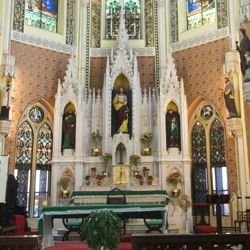
Cathedral of Holy Name, Mumbai is located in the commercial area of Colaba. This is the seat of the Archbishop and considered as Mother church of Archdiocese. The Cathedral was built in the era colonialism. The stone to the foundation of the building was placed on July 9th, 1902 and it was finally opened for its disciplines on January 15th, 1905. The Cathedral of the Holy Name got the name as the Heritage building in the year 1998. The devotees of this particular cathedral have their roots back from the Parish community which has a wish to fulfil all the mission and vision that was taken up. People who belong to this community gather in this place and offer parts. This place has a special place in the heart of the people. The main entrance door of this place is stated one among all the “Holy Doors of Mercy”. The Catholics walk pass this door to seek forgiveness and purification. This place is a pilgrimage site for all the Catholics. Pope Francis has declared that the door should be opened for all the devotees who come here for blessings. There was only one such door in the Vatican and later this place also made its way and got to be known as the 'Holy Doors Of Mercy'. Cathedral of Holy Name, Mumbai, is the witness of the life cycle of this particular community from their birth to death. This place consists of the Cathedral house, the fort convent and the Cathedral that is located at Wodehouse Road and spreads over an area of 4642 sq. yards. The place of the living for the Archbishop is near to the Cathedral. Things To Do The premises and the surrounding of the church are good for you to take a stroll. The people who visit here for the first time enjoy the peace and serenity and the lovely ambience that you get to witness in this cathedral. Along with enjoying and seeing the beautiful gothic architecture you can also join the Sunday mass, the Holy week services and also the special Easter. You are willing you can attend the daily mass that is attended mostly by the residents of the place. History Cathedral of Holy Name, Mumbai, has an amazing past and history behind. This place was the outcome of an agreement that was signed between the Bombay Improvement Trust and the Archbishop. The person who was hired by the Archbishops was Dalhoff. He was the one who erected the beautiful and magnificent structure. He also built the residential area and the school. The Bombay Trust passed and approved the plan on November 21st and in the year 1901. Within a year the construction of the place begun and the place was finally open for the devotees in the year 1905, January 15. Timings And Entry Fees The daily mass in English is held four times a day. The timings are 6:30 am, 7:30 am, 1:15 pm and 6:30 pm. For Konkani, you should visit around 5:30 pm. The Sunday mass in English is held at 6:30 am, 10 am and 6:30 pm. The Sunday mass in Konkani is at 7:30 am and 5:30 pm respectively. Rest all the other important things and information that you want can be collected from the office of the cathedral which is open from 9:30 to 1:00 pm and again in the evening from 4:00 pm to 6:00 pm. Sunday’s the place is fully closed and on Saturdays, it is a half-day. They do not have any entry fee to enter the Cathedral of Holy Name, Mumbai. Best Time To Visit You can visit the church at any time of the year. It is open all seasons and every day for visitors and the local community to offer prayers. Maharashtra, on the other hand, is an exotic place for all the travellers and it is one of the hotspots of India. This place showcases iconic attractions, green mountains, beaches, vineyards, pilgrimages and much more. This place is worth dying for. The three seasons of the year is summer, monsoon and winter. If you want to visit Cathedral of Holy Name, Mumbai in pleasant weather then you should plan your holidays from October to March. This is the best time for the visitors to witness the beautiful scenes and enjoy the amazing weather. How To Reach The City of Mumbai is well connected. You can reach here via road, rail or air, anything of your choice. Mumbai is one of the metropolitan cities of India and thus it has to be well-connected. You can choose your favourite mode of traveller and visit the place. This is the travel destination for all and easily accessible via air as it has both national and international airports with plenty of flights coming to and fro. The Cathedral of Holy Name, Mumbai is located at a significant zone of the city. Colaba us easily accessible and can be reached from any part of the city using local and public transportation.
Explore More
While visiting Mumbai, you should visit all the tourist spots in the city. St. Thomas Cathedral, Mumbai is one place that you should not avoid visiting. The church is one of the oldest and first Anglican type of churches in the city. The structure and history of the church make it even more attractive. It is located at the Horniman Circle and is very close to the Bombay House and Flora Fountain. The cathedral is a landmark in South Mumbai and is around 300 years old, which makes it the oldest church in the country. Since the Churchgate railway station was linked to the church by road, it was named after the church. The road led to one of the gates to the city which was demolished in 1862 to expand the city and was replaced by a fountain. History of St. Thomas Cathedral, Mumbai The cathedral was established in 1718 by the Anglican Church and was named after Saint Thomas the Apostle. In 1668, Sir John Oxinden thought of building a church for his men so that they had a place of workshop. In 1669, Gerald Aungier wanted to invite people to embrace religion. He also raised donations from the people working with East India Company which was used to build the church. The foundation stone of the church was laid in 1676 and finally, after a lot of interruptions, the church was built completely in 1718. It was inaugurated by Charles Boone, the then governor of the city.The first service in the church was held at Christmas. However, it wasn’t until the year 1837 that the church was sanctified as a cathedral and making Thomas Carr the first Bishop of Bombay. The clock and the tower were built in 1838. The Structure of the Church The St. Thomas Cathedral, Mumbai has been styled in the Neo-Gothic style to resemble the St. Thomas Cathedral in Ireland. When you enter the church, you will find a fountain and a memorial of the first Bishop of Bombay. The church is made from glasswork, brass, and plaster of Paris and has an arched shaped dome. The windows of the church are stained glass that shows St. Thomas’s contribution to religion. You will find St. Thomas between St. Gabriel, who is holding a lily a symbol of purity, and St. Michael, who is holding a double-edged sword that is a symbol for truth and justice. The Memorials in St. Thomas Cathedral, Mumbai The church has many memorials carved in stones from the Company rule in the country to the British Raj. These memorials include the effigy of Thomas Carr who was the first Bishop of Bombay. This effigy was carved by the British sculptor Matthew Noble. You will also find a memorial of Sir Frederick Lewis Maitland who was the Rear Admiral and Captain George Nicholas Hardinge. The Point Zero of Bombay During the colonial times, St. Thomas Cathedral, Mumbai was marked as the point zero of Bombay which is the centre of the city. 16 milestones were laid from the church of the city and lead way up to the north of the city. The stones were only 4 feet, but they got submerged into the ground as the roads kept being made over them all these years. Visiting Hours of the Church The church is open everyday from 7 am – 6 pm. Sunday mass is held along with Sunday school from 8.45 am onwards. Things to Do Near the Church Being close to the Horniman Circle, MG Road, and Lokhandwala, you can visit these places to enjoy some shopping. You can also grab some local delicacies of the city in these places. If you want to get the real taste of the local cuisines, then you should try some from local vendors on the streets. You can enjoy the Flora Fountain near the church that was once a road that led to the city gate. Other places that you can visit near the church are the University of Mumbai, Nariman Point, Asiatic Society of Mumbai, etc. Reaching the Oldest Church in India The church is very famous and known to everyone in the city. This also makes it easily accessible through local transports. Auto-rickshaws, buses, and taxis ply on the road to the church. There are also many local trains that stop at MG Road from where the church is around a 5-minute walk. If you do not feel like walking, then you can take a taxi or an auto from the station.
Explore More
About The Balaji Temple The Balaji Temple, also known as the Shri Balaji Temple, is a famous Hindu temple located in Nagpur, Maharashtra. It is dedicated to Lord Venkateswara, an incarnation of the Hindu god Vishnu. The temple is a popular pilgrimage site for devotees who come to seek blessings and offer prayers to Lord Balaji. Architecture of Balaji Temple The Balaji Temple is renowned for its magnificent architecture, featuring intricate carvings and stunning sculptures. The main sanctum sanctorum houses the idol of Lord Venkateswara, adorned with jewels and flowers. The temple complex also includes shrines dedicated to other deities such as Lord Ganesha, Lord Hanuman, and Goddess Lakshmi. The architecture of the Balaji Temple is a beautiful blend of traditional South Indian and contemporary styles, making it a unique and visually appealing structure. The temple's gopuram (tower) is adorned with colorful sculptures depicting various episodes from Hindu mythology, adding to its grandeur. History The Balaji Temple was established in the late 19th century by a group of devotees who wanted to create a sacred place for worshiping Lord Venkateswara. Over the years, the temple has undergone several renovations and expansions, but its spiritual significance has remained unchanged. According to legend, the idol of Lord Venkateswara in the Balaji Temple is a self-manifested deity that is believed to have miraculous powers. Many devotees visit the temple to offer prayers and seek blessings for their well-being and prosperity. Best Time To Visit The best time to visit the Balaji Temple is during the annual festivals and special occasions dedicated to Lord Venkateswara. The temple is particularly crowded during festivals like Vaikuntha Ekadashi, Panguni Uttiram, and Brahmotsavam, when devotees throng to the temple to participate in the celebrations. For those who prefer a quieter and more serene visit, weekdays are generally less crowded compared to weekends and holidays. The weather in Nagpur is pleasant during the winter months, making it an ideal time to visit the temple and explore the surrounding areas. How To Reach The Balaji Temple is located in the heart of Nagpur city, making it easily accessible by road, rail, and air. The temple is situated near the Nagpur Railway Station, which is well-connected to major cities across India. Visitors can also reach the temple by hiring a taxi or auto-rickshaw from any part of the city. For those traveling by air, the Dr. Babasaheb Ambedkar International Airport in Nagpur is the nearest airport to the temple. From the airport, visitors can hire a cab or take a bus to reach the Balaji Temple conveniently. Significance Of The Balaji Temple The Balaji Temple holds great significance for devotees who believe in the power and benevolence of Lord Venkateswara. Many people visit the temple to seek blessings for their families, health, and prosperity. The temple also serves as a spiritual retreat for those seeking solace and inner peace. Devotees often perform rituals and offer prayers at the temple to fulfill their wishes and express their gratitude to the divine. The serene atmosphere and spiritual ambience of the Balaji Temple create a sense of tranquility and devotion among visitors, making it a sacred place of worship for people of all ages and backgrounds. In conclusion, the Balaji Temple in Nagpur is not just a religious site but a symbol of faith, devotion, and cultural heritage. Its stunning architecture, spiritual significance, and historical legacy make it a must-visit destination for anyone seeking a spiritual experience in the city of Nagpur.
Explore More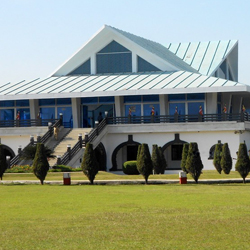
About The Dragon Palace Temple The Dragon Palace Temple is a stunning Buddhist temple located in Kamptee, near Nagpur in the state of Maharashtra, India. It is one of the most important places of worship for Buddhists in the region and attracts visitors from around the world. The temple complex is spread over a vast area and is known for its beautiful architecture, serene surroundings, and spiritual ambiance. Architecture of The Dragon Palace Temple The architecture of The Dragon Palace Temple is a perfect blend of traditional Buddhist design elements and modern aesthetics. The main temple building is adorned with intricate carvings, colorful murals, and ornate statues of Buddha and other deities. The temple complex also features lush gardens, fountains, and a large prayer hall where devotees can meditate and offer their prayers. History The Dragon Palace Temple was built in the late 1980s by a group of dedicated Buddhist monks and followers. The temple complex was inspired by the ancient Nalanda University in India and the traditional Buddhist monasteries of Tibet. Over the years, the temple has become a center of Buddhist culture, education, and spiritual practice in the region. Best Time To Visit The Dragon Palace Temple can be visited throughout the year, but the best time to visit is during the months of October to March when the weather is pleasant and conducive for sightseeing. The temple is also beautifully decorated during festivals like Buddha Purnima and attracts a large number of devotees and tourists during these times. How To Reach The Dragon Palace Temple is located in Kamptee, near Nagpur in Maharashtra. It is easily accessible by road from Nagpur city, which is well-connected to major cities in India by air, rail, and road. Visitors can hire a taxi or take a bus from Nagpur to reach the temple complex. The nearest railway station is also located in Nagpur, which is connected to all major cities in India. Significance Of The Dragon Palace Temple The Dragon Palace Temple holds great significance for Buddhists as a place of worship, meditation, and spiritual learning. The temple complex is home to several sacred relics, scriptures, and artifacts related to Buddha and his teachings. It is also a place where monks and followers come together to practice mindfulness, compassion, and other virtues advocated by Buddhism. In conclusion, The Dragon Palace Temple in Nagpur is a must-visit destination for anyone interested in exploring Buddhist culture, art, and spirituality. The temple's serene surroundings, stunning architecture, and rich history make it a truly special place that leaves a lasting impression on all who visit.
Explore More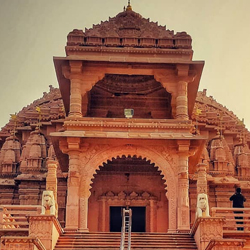
Shantinath Digambar Jain Temple
About Shantinath Digambar Jain Temple, Nagpur Shantinath Digambar Jain Temple, located in Nagpur, is a significant religious site for the Jain community. Dedicated to Lord Shantinath, the temple is renowned for its stunning architecture and serene ambiance. History, Architecture, and Design The Shantinath Digambar Jain Temple was built in the early 20th century and showcases traditional Jain architecture. The temple's intricate carvings, marble pillars, and colorful domes are a sight to behold. Its peaceful surroundings and ornate design make it a must-visit for architecture enthusiasts and spiritual seekers alike. Best Time to Visit The temple is open throughout the year, but the best time to visit is during the Jain festivals such as Mahavir Jayanti or Paryushan Parva. Avoid visiting during peak hours to experience a more peaceful and tranquil atmosphere. Cultural Significance The Shantinath Digambar Jain Temple holds great cultural significance for the Jain community. It is a place of worship and reflection, where devotees come to seek blessings, offer prayers, and engage in spiritual practices. Pilgrimage Practices Devotees visiting the temple often engage in traditional Jain practices such as meditation, prayers, and offerings. It is believed that by following these practices, one can attain spiritual enlightenment and inner peace. Dress Code and Etiquette Visitors to the Shantinath Digambar Jain Temple are expected to dress modestly and respectfully. It is customary to remove footwear before entering the temple premises and maintain a quiet and reverent demeanor while inside. Activities and Experiences Some of the activities and experiences that visitors can enjoy at the temple include participating in religious ceremonies, attending lectures on Jain philosophy, and exploring the temple's beautiful surroundings. The tranquil atmosphere and spiritual energy of the temple make it an ideal place for introspection and meditation. Art and Religious Symbols The Shantinath Digambar Jain Temple is adorned with intricate artwork and religious symbols that hold deep significance for the Jain community. The temple's walls are adorned with colorful paintings depicting scenes from Jain mythology and teachings, while its architecture is a testament to the rich heritage and spiritual beliefs of the Jain faith. Local Insights Visitors to the Shantinath Digambar Jain Temple can gain insights into the local Jain community's customs, traditions, and way of life. Interacting with local devotees and participating in temple activities can provide a deeper understanding of Jain culture and spirituality.
Explore More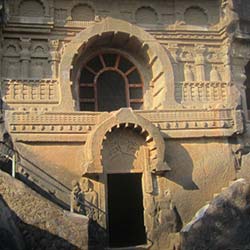
About 8 Kms South of Nasik, is a group of 24 Hinayana Buddhist Caves dating from around the 1st century BC to the 2nd AD. The most important in this group are number 18 and 20. Except caves no. 18, the rest of the caves are Viharas or Monasteries. This group of caves is one of the most important and intriguing in western India. The oldest historical place in Nashik is Pandav caves which are also known as Trirashmi Leni. The famous Dadasaheb Phalke Smarak and Buddhasmarak are soon to be opened for public, which are known for their creativity and only of their kind. Cave 3 is a large vihara with some interesting sculptures. Cave 10 is also a vihara and almost identical in design to cave 3, although it is much older and finer in its detail. It is thought to be nearly as old as the Karla Cave near Lonavala. Cave 18 is a chaitya believed to date from the same time as the Karla Cave and is well sculptured. Its elaborate facade is particularly noteworthy. The cave houses the idols of Buddha, Jain Teerthankara Vrishabhdeo, the icons of Bodhisatva, Veer Manibhadraji and Ambikadevi. The interiors of the caves were popular meeting places for the disciples, where sermons were conducted. There are attractive water tanks very skillfully chiselled into the rock. The 2000-yr-old Pandavleni caves, built by the Jain kings, are located on a tableland atop the Trivashmi Hill, close to the Mumbai Road.
Explore More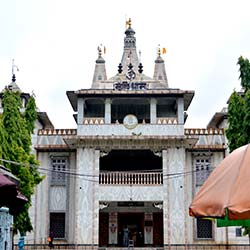
About The Muktidham Temple The Muktidham Temple is a famous Hindu temple located in Nashik, Maharashtra. It is dedicated to various Hindu gods and is a popular pilgrimage site for devotees. The temple is known for its beautiful architecture and religious significance, making it a must-visit destination for spiritual seekers. Architecture of Muktidham Temple The Muktidham Temple is constructed using white Makrana marble, which gives it a stunning and pristine appearance. The temple complex is spread over a vast area and consists of various shrines dedicated to different deities, including Lord Rama, Goddess Durga, Lord Hanuman, and Lord Ganesha. The intricate carvings and ornate decorations on the walls and ceilings of the temple add to its grandeur and beauty. History The construction of the Muktidham Temple was initiated by the Birla family in the 1970s. The temple was built as a tribute to various Hindu gods and to promote spiritual awareness among the people. The temple's inauguration took place in 1971 and since then, it has been a popular place of worship for devotees from all over the country. Best Time To Visit The best time to visit the Muktidham Temple is during the winter months, from November to February, when the weather is pleasant and conducive for sightseeing. The temple also sees a surge in visitors during festivals like Diwali and Dussehra, as special ceremonies and rituals are conducted during these auspicious occasions. How To Reach The Muktidham Temple is located in Nashik, Maharashtra, and is easily accessible by road and rail. The nearest airport is the Nashik Airport, which is well-connected to major cities in India. Visitors can also reach the temple by taking a bus or hiring a taxi from Nashik city, which is approximately 8 kilometers away. Significance Of The Muktidham Temple The Muktidham Temple holds immense significance for devotees as it is believed to be a place where one can attain salvation or 'mukti' from the cycle of birth and death. The temple's sanctity and spiritual ambiance attract thousands of pilgrims every year who come to seek blessings and offer prayers to the deities. The temple also serves as a cultural and religious hub, hosting various events and ceremonies throughout the year. Overall, the Muktidham Temple in Nashik is a place of great religious importance and architectural beauty, making it a must-visit destination for those seeking spiritual enlightenment and divine blessings.
Explore More
Tapovan is one of the most significant and serene places in Nashik, Maharashtra. Known for its deep-rooted connection with Hindu mythology, it attracts pilgrims, nature lovers, and history enthusiasts. If you are planning to visit Tapovan, here is everything you need to know from a traveler’s perspective. Tapovan is a sacred site that holds immense mythological importance. The name ‘Tapovan’ is derived from two Sanskrit words: ‘Tapas’ (penance) and ‘Vana’ (forest), meaning ‘the forest of penance.’ According to legends, this is the place where Lord Rama, along with his wife Sita and brother Lakshmana, spent a part of their exile (Vanvaas). It is also believed that Sage Agastya and other saints performed meditation (Tapasya) here. Nestled along the banks of the River Godavari, Tapovan is not just a religious site but also a natural retreat, offering a peaceful ambiance and lush greenery. Why Visit Tapovan? Mythological Significance: Tapovan is closely linked to the epic Ramayana. The spot where Lakshmana cut off Surpanakha’s nose is believed to be here, giving Nashik its name (‘Nasika’ meaning nose in Sanskrit). Spiritual Experience: The place is considered sacred and offers a tranquil environment for meditation, yoga, and prayers. Scenic Beauty: The area is surrounded by dense forests, the flowing River Godavari, and picturesque landscapes, making it a perfect place for relaxation. Ideal for Photography: If you love capturing natural beauty and historical sites, Tapovan offers plenty of opportunities. A Must-Visit for Pilgrims: The site is an essential part of the Panchavati pilgrimage circuit in Nashik. Major Attractions in Tapovan 1. Sita Gufa (Sita Cave) : A small cave where Goddess Sita is believed to have stayed during exile. The cave is dark and narrow, adding to the thrill of exploration. 2. Ram Kund : A sacred pond on the Godavari River where devotees perform religious rituals. Pilgrims believe taking a dip in Ram Kund purifies the soul. 3. Lakshmana Temple: Dedicated to Lord Lakshmana, this temple marks the place where he performed penance. 4. Godavari River: Flowing beside Tapovan, the river adds to the tranquility of the place. Visitors often sit by the riverbank to enjoy peaceful moments. 5. Meditation Spots: Various ashrams and open spaces where visitors can meditate in a calm environment. Best Time to Visit Tapovan Nashik The ideal time to visit Tapovan is during the winter and early summer months: October to March: Pleasant weather, making exploration comfortable. July to September: Monsoon season brings greenery, but heavy rains might make travel difficult. April to June: Summer months can be hot, but early mornings and evenings are still enjoyable. How to Reach Tapovan? Tapovan is well-connected by road, rail, and air: By Air: The nearest airport is Ozar Airport (Nashik Airport), about 25 km away. By Train: Nashik Road Railway Station is the nearest railway station, approximately 10 km away. By Road: Tapovan is easily accessible by taxis, auto-rickshaws, and private vehicles from Nashik city. Nearby Attractions If you are visiting Tapovan, consider exploring these nearby places: Panchavati: Another sacred area linked to the Ramayana, just 3 km away. Trimbakeshwar Temple: One of the 12 Jyotirlingas of Lord Shiva, around 30 km from Nashik. Sula Vineyards: For a different experience, visit Nashik’s famous wine yards, approximately 20 km away. Anjaneri Hills: Believed to be the birthplace of Lord Hanuman, great for trekking. Things to Keep in Mind Respect the Sacredness: Since Tapovan is a religious site, visitors should dress modestly and avoid loud behavior. Carry Essentials: If you plan to explore caves and trails, wear comfortable shoes and carry water. Photography: Allowed in most areas but seek permission at certain religious sites. Local Cuisine: Try Nashik’s local delicacies like Misal Pav and Puran Poli at nearby eateries. Tapovan, Nashik, is a must-visit destination for anyone interested in mythology, spirituality, and nature. Whether you seek religious enlightenment, a peaceful getaway, or a chance to explore historical sites, Tapovan offers it all. With its deep-rooted legends, beautiful surroundings, and calm atmosphere, it is an experience that stays with every visitor. So, if you are planning a trip to Nashik, make sure to add Tapovan to your itinerary and immerse yourself in its divine and natural beauty! You can also explore Nashik travel packages that include guided tours, accommodation, and transportation, ensuring a hassle-free and enriching travel experience.
Explore More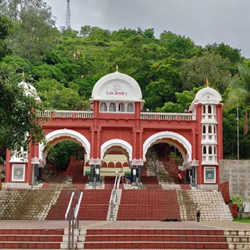
About The Chaturshringi Temple in Pune The Chaturshringi Temple is a famous Hindu temple located in Pune, Maharashtra, India. It is dedicated to the goddess Chaturshringi, who is believed to be the presiding deity of the city. The temple is situated on a hill, which is named after the temple itself. Architecture of Chaturshringi Temple The Chaturshringi Temple is known for its unique architecture and design. The temple complex is built in the Peshwa style of architecture, with a large courtyard surrounded by several smaller shrines. The main temple is located at the top of the hill and is accessible by a flight of steps. The temple is adorned with intricate carvings and sculptures, depicting various mythological stories. History The Chaturshringi Temple has a rich history dating back to the 18th century. It was built during the reign of the Maratha Empire, under the patronage of the Peshwa rulers. The temple was constructed to honor the goddess Chaturshringi, who is believed to be a powerful deity worshipped for protection and prosperity. Best Time To Visit The best time to visit the Chaturshringi Temple is during the months of October to February, when the weather is pleasant and cool. The temple is also beautifully decorated during the Navratri festival, which falls in the month of October. Thousands of devotees visit the temple during this time to seek the blessings of the goddess. How To Reach The Chaturshringi Temple is easily accessible by road and is located at a distance of 8 kilometers from the Pune city center. Visitors can hire a taxi or take a local bus to reach the temple. The nearest airport is the Pune Airport, which is about 15 kilometers away from the temple. The temple is also well-connected by public transportation. Significance Of The Chaturshringi Temple The Chaturshringi Temple holds great significance for the people of Pune and is considered a sacred place of worship. Devotees visit the temple to seek the blessings of the goddess Chaturshringi for protection, prosperity, and well-being. The temple also holds cultural and religious events throughout the year, attracting a large number of pilgrims and tourists. In conclusion, the Chaturshringi Temple is a revered religious site in Pune with a rich history and unique architecture. Visitors can experience peace and tranquility at the temple and seek the blessings of the goddess for a fulfilling life. The temple is a must-visit destination for those seeking spiritual enlightenment and cultural immersion in the vibrant city of Pune.
Explore More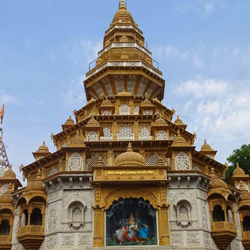
About The Dagdusheth Halwai Temple The Dagdusheth Halwai Temple, located in Pune, Maharashtra, is a well-known Hindu temple dedicated to the deity Lord Ganesha. It is one of the most popular temples in the city and is visited by thousands of devotees every day. The temple is named after its founder, Dagdusheth Halwai, who was a successful sweet seller and a devout follower of Lord Ganesha. Architecture of Dagdusheth Halwai Temple The architecture of the Dagdusheth Halwai Temple is a beautiful blend of Maratha and Mughal styles. The temple is adorned with intricate carvings, colorful decorations, and a majestic entrance gate. The main idol of Lord Ganesha is made of gold and is adorned with precious jewels. The temple also has a spacious courtyard where devotees can sit and meditate. History The Dagdusheth Halwai Temple was established in the late 19th century by Dagdusheth Halwai and his wife Lakshmibai. The couple built the temple as a way to express their gratitude to Lord Ganesha for their prosperity and success in business. Since then, the temple has become a symbol of devotion and faith for the people of Pune. Best Time To Visit The best time to visit the Dagdusheth Halwai Temple is during the festival of Ganesh Chaturthi, which usually falls in the month of August or September. During this time, the temple is decorated with lights, flowers, and garlands, and there are special prayers and ceremonies held in honor of Lord Ganesha. How To Reach The Dagdusheth Halwai Temple is located in the heart of Pune city, making it easily accessible by road. Visitors can take a taxi, auto-rickshaw, or public bus to reach the temple. The nearest railway station is Pune Junction, which is about 3 km away from the temple. Pune International Airport is also located at a distance of around 12 km from the temple. Significance Of The Dagdusheth Halwai Temple The Dagdusheth Halwai Temple holds great significance for the devotees of Lord Ganesha. It is believed that praying at this temple can fulfill one's wishes and bring prosperity and success. Many people visit the temple to seek blessings for their families, careers, and overall well-being. The temple also plays a vital role in the cultural and religious life of Pune, hosting various festivals and events throughout the year. Overall, the Dagdusheth Halwai Temple is a sacred place of worship, architectural beauty, and historical importance that attracts visitors from all over the country. It stands as a symbol of devotion, faith, and spiritual connection to the divine.
Explore More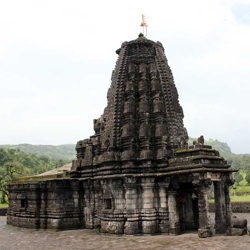
Siddheshwar & Ratneshwar Temples
About The Siddheshwar & Ratneshwar Temples The Siddheshwar & Ratneshwar Temples are two ancient temples located in the city of Latur in Maharashtra, India. These temples are dedicated to Lord Shiva and are considered to be significant religious sites for the followers of Hinduism. The Siddheshwar Temple is also known as Siddheshwar Jyotirlinga Temple, while the Ratneshwar Temple is dedicated to the goddess Parvati, also known as Ratnai. These temples are revered by devotees who visit to seek blessings, offer prayers, and participate in various religious ceremonies. Architecture of Siddheshwar & Ratneshwar Temples The Siddheshwar Temple is an architectural marvel that combines traditional Hindu temple architecture with intricate carvings and sculptures. The temple complex features a large sanctum sanctorum where the main idol of Lord Shiva is enshrined. The outer walls of the temple are adorned with beautiful sculptures depicting various Hindu deities, mythological stories, and intricate designs. The Ratneshwar Temple, on the other hand, follows a similar architectural style with a smaller structure dedicated to the goddess Parvati. History The history of the Siddheshwar & Ratneshwar Temples dates back several centuries, with the Siddheshwar Temple believed to have been built during the Yadava dynasty in the 12th century. The temples have undergone renovations and additions over the years, but have retained their original architectural grandeur and spiritual significance. The Ratneshwar Temple was constructed later as a compliment to the Siddheshwar Temple, further enhancing the religious importance of the temple complex. Best Time To Visit The best time to visit the Siddheshwar & Ratneshwar Temples is during the winter months of October to February when the weather is pleasant and conducive for exploring the temple complex. The annual festivals of Maha Shivaratri and Navratri are celebrated with great fervor at the temples, with devotees from all over the region coming to participate in the festivities. It is advisable to check the temple's schedule for specific dates and timings of religious events before planning your visit. How To Reach The Siddheshwar & Ratneshwar Temples are easily accessible by road, as Latur is well-connected to major cities in Maharashtra. The nearest airport is located in Aurangabad, approximately 250 kilometers away, with regular flights to Mumbai and other major cities. Latur also has a railway station that is connected to major towns and cities in Maharashtra. Local transportation options such as buses, taxis, and auto-rickshaws are available for commuting within the city. Significance Of The Siddheshwar & Ratneshwar Temples The Siddheshwar & Ratneshwar Temples hold immense religious and cultural significance for the people of Latur and the surrounding regions. Devotees visit the temples to seek blessings, offer prayers, and perform rituals to Lord Shiva and the goddess Parvati. The temples are believed to fulfill the wishes of the devotees who come with a pure heart and sincere devotion. The spiritual aura and divine ambiance of the temples make them a must-visit destination for those seeking solace and spiritual enlightenment.
Explore More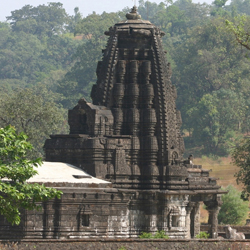
About The Amruteshwar Temple The Amruteshwar Temple is an ancient Hindu temple located in Bhandara, Maharashtra. It is dedicated to Lord Shiva and is known for its exquisite architecture and historical significance. The temple is believed to have been built in the 8th century and is one of the oldest temples in the region. Architecture of Amruteshwar Temple The Amruteshwar Temple is renowned for its unique Hemadpanthi architectural style, which is characteristic of temples built during the Yadava dynasty. The temple is built using black basalt stone and features intricate carvings and sculptures of various deities. The main sanctum sanctorum houses a Shivlinga (symbol of Lord Shiva) and is surrounded by smaller shrines dedicated to other gods and goddesses. History The Amruteshwar Temple has a rich history that dates back centuries. It is believed to have been constructed during the rule of the Yadava dynasty, which flourished in the region between the 11th and 13th centuries. The temple has undergone several renovations and additions over the years, but its original architecture and design have been preserved. It stands as a testimony to the rich cultural and religious heritage of Maharashtra. Best Time To Visit The best time to visit the Amruteshwar Temple is during the winter months, from October to February, when the weather is pleasant and conducive for sightseeing. The temple is also less crowded during this time, allowing visitors to explore its beauty in peace. However, the temple is open to visitors throughout the year, so you can plan your visit according to your convenience. How To Reach The Amruteshwar Temple is located in Bhandara, Maharashtra, which is well-connected by road and rail. The nearest railway station is Bhandara Road, which is about 5 kilometers away from the temple. You can also reach Bhandara by road via bus or taxi from major cities like Nagpur, which is about 70 kilometers away. The temple is easily accessible and can be reached conveniently from any part of Maharashtra. Significance Of The Amruteshwar Temple The Amruteshwar Temple holds great significance for devotees of Lord Shiva and is a popular pilgrimage site in Maharashtra. The temple is believed to possess divine powers and is visited by thousands of devotees every year. It is also a symbol of the rich architectural heritage of the region and attracts tourists and history enthusiasts from around the country. The Amruteshwar Temple is not just a religious site but also a cultural landmark that reflects the glory of ancient India. Overall, the Amruteshwar Temple in Bhandara is a must-visit destination for anyone interested in history, architecture, and spirituality. Its serene surroundings, intricate carvings, and divine aura make it a truly enchanting place to explore and experience the timeless beauty of Hindu culture.
Explore MoreShirdi Darshan
2 Days/ 1 Night
Shirdi
Tadoba With Nagzira - Pench National Park Tour 6 Night
7 Days/ 6 Night
Chandrapur - Nagpur - Seoni
2N - 3D Mahabaleshwar Tour Ex - Mumbai
3 Days/ 2 Night
Mahabaleshwar - Panchgani
4 Night - 5 Days Maharashtra 3 Jyotirlinga Darshan Tour
5 Days/ 4 Night
Aurangabad - Pune - Shirdi - Trimbakeshwar - Shani Shingnapur
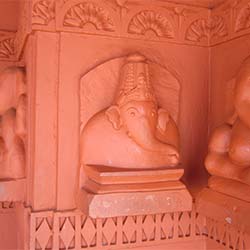
About The Ganpatipule Temple The Ganpatipule Temple is a famous Hindu temple located in Ganpatipule, Ratnagiri district in Maharashtra, India. It is dedicated to the Hindu god Ganesha, who is also known as "Ganpati" in the local language. The temple is situated on the Konkan coast and is one of the most visited Ganesh temples in India. Architecture of Ganpatipule Temple The Ganpatipule Temple is built in the traditional Konkan style of architecture, with a white facade and a towering spire. The temple is located right on the pristine Ganpatipule beach, offering devotees a breathtaking view of the Arabian Sea. The sanctum sanctorum houses a swayambhu (self-manifested) idol of Ganesha, which is believed to be thousands of years old. History The history of the Ganpatipule Temple dates back to centuries ago, with references to the temple found in ancient texts and scriptures. According to local legends, the temple was built by a sage named Morya Gosavi, who discovered the swayambhu idol of Ganesha while on a pilgrimage. The temple has since been renovated and expanded several times, but the original idol remains unchanged. Best Time To Visit The best time to visit the Ganpatipule Temple is during the winter months, from November to February, when the weather is pleasant and cool. The temple is also less crowded during this time, allowing devotees to have a peaceful darshan (sight) of the deity. The temple is open all year round, and special festivals like Ganesh Chaturthi and Maghi Ganesh Jayanti are celebrated with great pomp and fervor. How To Reach The Ganpatipule Temple is easily accessible by road, rail, and air. The nearest airport is in Ratnagiri, which is about 50 kilometers away from the temple. The nearest railway station is in Ratnagiri as well, which is well-connected to major cities in Maharashtra. Buses and taxis are available from Ratnagiri to Ganpatipule, making it convenient for devotees to reach the temple. Significance Of The Ganpatipule Temple The Ganpatipule Temple holds great significance for devotees, who believe that visiting the temple and seeking the blessings of Ganesha can bring peace, prosperity, and success in their lives. The temple is also believed to fulfill wishes and desires of the devotees, who offer prayers and perform rituals with devotion. The tranquil setting of the temple, surrounded by lush greenery and the pristine beach, adds to the spiritual experience of the visitors. In conclusion, the Ganpatipule Temple is not just a place of worship, but also a symbol of faith, devotion, and cultural heritage. Its serene atmosphere and stunning location make it a must-visit destination for spiritual seekers and tourists alike.
Explore More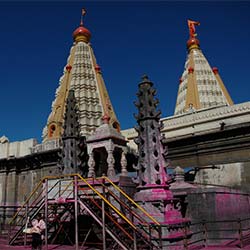
About The Jyotiba Temple The Jyotiba Temple, located in Kolhapur, Maharashtra, is a popular Hindu pilgrimage site dedicated to the deity Jyotiba. The temple is situated atop a hill and offers breathtaking views of the surrounding lush greenery. Devotees from all over the country visit this sacred site to seek blessings and fulfill their wishes. Architecture of Jyotiba Temple The Jyotiba Temple has a unique architectural style that showcases a blend of traditional Marathi and Hindu architectural elements. The temple complex consists of multiple structures, including the main shrine, prayer halls, and smaller temples dedicated to other deities. The intricate carvings and sculptures adorning the temple walls reflect the rich cultural heritage of the region. History The history of the Jyotiba Temple dates back several centuries. It is believed that the temple was built by the Yadava dynasty rulers in the 12th century. Over the years, the temple has undergone several renovations and expansions, making it the grand structure that it is today. The temple holds great religious and historical significance for the local community and devotees. Best Time To Visit The best time to visit the Jyotiba Temple is during the winter months of October to March when the weather is pleasant and ideal for exploring the temple complex. The annual Jyotiba Yatra, held in the months of March or April, is a popular festival when devotees flock to the temple to celebrate and offer prayers. How To Reach The Jyotiba Temple is easily accessible by road, located about 20 kilometers from Kolhapur city. Visitors can hire a taxi or take a bus from the city to reach the temple. The nearest railway station is Kolhapur Railway Station, and the nearest airport is Kolhapur Airport. From there, one can hire a cab or use public transportation to reach the temple. Significance Of The Jyotiba Temple The Jyotiba Temple holds great religious significance for devotees who believe that worshipping Jyotiba can fulfill their wishes and bring them success and prosperity. The deity is considered a manifestation of the Hindu god Shiva and is worshipped for protection and blessings. The temple is also associated with various myths and legends that add to its mystical aura. Overall, the Jyotiba Temple in Kolhapur is a must-visit destination for those seeking spiritual solace and a glimpse into the rich cultural heritage of Maharashtra. With its stunning architecture, historical significance, and picturesque location, the temple offers a truly enriching experience for visitors of all ages.
Explore More
About The Kopeshwar Temple The Kopeshwar Temple, located in Kolhapur, Maharashtra, is a stunning example of ancient Indian architecture and religious significance. This temple is dedicated to Lord Shiva and is known for its intricate carvings, towering pillars, and unique architectural style. The temple is a popular pilgrimage site for devotees and tourists alike, seeking spiritual enlightenment and cultural exploration. Architecture of Kopeshwar Temple The Kopeshwar Temple showcases a mix of the Hemadpanthi and Yadava styles of architecture, dating back to the 12th century. The temple is built using black stone and features intricate carvings of gods, goddesses, and mythical creatures. The main shrine houses a large Shiva Lingam, surrounded by smaller shrines dedicated to other deities. The temple's impressive pillars and domes add to its grandeur and make it a sight to behold. History The Kopeshwar Temple was built during the Yadava dynasty, under the patronage of the rulers of the region. It is believed that the temple was constructed by Basant Rao Saraf, a wealthy merchant, in honor of his late wife. The temple's construction took several years to complete, with contributions from various artisans and craftsmen. Over the years, the temple has undergone renovations and repairs, but has retained its original charm and beauty. Best Time To Visit The best time to visit the Kopeshwar Temple is during the winter months, from October to February, when the weather is pleasant and ideal for exploring the temple complex. The annual festivals of Mahashivratri and Kartik Purnima are celebrated with great fervor at the temple, drawing large crowds of devotees. Visitors can also witness the grandeur of the temple during these festive occasions. How To Reach The Kopeshwar Temple is located in Khidrapur, around 60 kilometers from Kolhapur city. Visitors can reach the temple by road, either by private vehicle or public transport. Kolhapur is well-connected to major cities in Maharashtra by road and rail, making it easy for tourists to access the temple. The nearest airport is in Kolhapur, which is around 80 kilometers away from the temple. Significance Of The Kopeshwar Temple The Kopeshwar Temple holds immense religious significance for devotees of Lord Shiva. It is believed that worshipping at the temple can bring blessings, prosperity, and fulfillment of desires. The temple also serves as a cultural heritage site, showcasing the rich architectural and sculptural traditions of ancient India. Visitors to the temple can experience a sense of peace and tranquility, amidst the divine aura and sacred surroundings. In conclusion, the Kopeshwar Temple in Kolhapur is a marvel of ancient Indian architecture and religious devotion. With its intricate carvings, grand pillars, and spiritual significance, the temple stands as a testament to the rich cultural heritage of the region. Visiting the Kopeshwar Temple is not just a journey of faith, but also a unique opportunity to explore the artistic and architectural wonders of ancient India.
Explore More
The Shri Mahalakshmi Temple of Kolhapur is in Maharashtra, India. It is well known among all other temples across India. It is the Shakti Peetha which is also called Dakshin Kashi and is listed in various Puranas of Hinduism. Puranas are the sacred writings which tell us about the stories of Deities and as per these writings, a shakti peetha is a place related to Shakti, the goddess of power. This is the Kolhapur shakti peetha which is of special spiritual significance. It is known as one of the six places where it is supposed to obtain either salvation from desires or fulfil them. This temple takes has taken its name from Mahalakshmi, the spouse of Vishnu, and is assumed that the heavenly couple to be present in the area. The architecture of Mahalakshmi Temple, Kolhapur Architecturally, this temple belongs to the Kannada Chalukya Empire. The shrine of the goddess is constructed of gemstone with a weight of 40 kilograms. It is mounted on a stone platform with an appearance having four arms and crown. The shrine of Mahalakshmi is engraved in black stone with 3 feet height. There is a Shri yantra engraved on one of the walls inside the temple. You will see a mesmerizing statue of a lion made of stone that is the vahana of the goddess, stands behind the goddess statue. The entrance: The main entrance is called as Mahadwara of the temple is in the west. After you enter the Mahadwara you will be confronted with several deepamaalas on either side. Then you will enter the Garuda mandap with square pillars and foliated curvatures of wood. These are usually the basic characteristic of Maratha temples. This mandap is very old as it belongs to the 18th century. An image of garuda and another stone mandap also faces the temple on a raised platform enshrining Ganesh. Following thems is the third mandap with three monuments facing west. The central one is that of Mahalakshmi. It is surrounded with shrines on either side is of Mahakali and Mahasaraswathi. The temple complex displays mortarless structure echoing the elegance of the early Deccan temples. Also here are the horizontal mouldings and the perpendicular equalizers which generate a rich light and shade decoration. A rich display of sculpture of figurines in dancing poses, artistes, gods and goddesses are also seen in this temple. The three shrines have rather simple shikharas of brick and mortar age-old back from the 19th century. Above the Mahalakshmi temple, there is a temple with Shivalingam and a Nandi. facing the north, east and the south are The devakoshtas houses Venkatesha, Katyayani and Gowri Shankar. There are several subordinate memorials in the enclosure are of • Navagrahas, • Surya, • Mahishasuramardini, • Vitthal-Rakhmai, • Shiva, • Vishnu, • Tulja Bhavani and more Timings of Pooja Five worship services are presented to the Devi each day here. Time of Pooja: 5 A.M. to 11.00 A.M The first one starts at 5 am, involving the awakening of the goddess with a Kakada – torch, to the supplement of chants and choruses. The second worship service starts at 8 am involving the offerings of the Shodashopachara pooja which includes 16 elements. The afternoon, evening and Sheja-arati pooja make the three other services offered to the goddess. Festival celebrated Kartik festival is celebrated with huge enthusiasm. This festival starts at Narak Chaturdashi to Kartik Poornima. During this period the Temple is opened early at 2.00 a.m. and Kakada Aarati is performed at that time. Best time to Visit Mahalaxmi temple People should visit the temple during festivals like Kartik festival and Kirnostav. Kirnotsav is the festival celebrated when the rays of Sun fall on the idol of Mahalaxmi during Sunset. It is celebrated on November – 9, 10, 11 January to 31 January February 1 and 2 Places to visit near Mahalaxmi Temple, Kolhapur 1. Radhanagari Dam 2. Chandrakant Mandare art gallery 3. Narsobawadi 4. Khidrapur 5. Khasbag maidan 6. Rankala Lake 7. Jotiba temple 8. Siddhagiri museum 9. New palace 10. Bhavani mandap 11. Vishalgad fort Things to do in Kolhapur • Boating at Rankala Lake • Watch wrestling battle at Khasbag maidan • Enjoy stage performances, plays & Lavani at Keshavrao Bhosale & Shahu Smarak Hall • Get funfilled at Mohite’s racing track - a national grade go-kart racing track over the carts available. • Watch movies at the only multiplex with 3 wide screens • Dreamworld water park is a treat for water game lovers. • Perfect venue for a family treat is Gandharva resort • Get a taste of spine-chilling experiences in snow games at Kent Club’s Horror World. How to reach Mahalaxmi temple in Kolhapur? Kolhapur is around 45- km to the south of Mumbai. It is well connected to other adjacent places. You will take 8-10 hours to travel to this place from Mumbai or Bangalore. MSTC provides regular service on this route. So you can easily travel by road in semi-luxury and regular buses. Local transport is available at the station and bus stop like auto-rickshaw and taxis to take you to the temple. Check the temperature and season before booking your tickets. The rainy season is usually not a good season to plan a visit due to heavy rain. Winters are preferably the best due to a nominal coolness. Planning before time could get you several lucrative deals available in packages. For that, you need to explore various travel websites offering tour package to Kolhapur.
Explore More
About The Bhairavnath Temple The Bhairavnath Temple is a revered Hindu temple located in the picturesque town of Lonavala, Maharashtra. Dedicated to Lord Bhairavnath, a fierce manifestation of Lord Shiva, this temple holds immense significance among devotees and tourists alike. The temple is known for its spiritual ambiance and stunning architecture, making it a must-visit destination for those seeking solace and blessings. Architecture of Bhairavnath Temple The Bhairavnath Temple boasts a unique architectural style that is a blend of traditional and contemporary designs. The temple complex is characterized by its intricate carvings, stunning sculptures, and vibrant paintings depicting various Hindu mythological stories. The main sanctum sanctorum of the temple houses the idol of Lord Bhairavnath, adorned with flowers and garlands by the devotees. The temple's exterior is equally impressive, with ornate pillars, towering spires, and a grand entrance that welcomes visitors with open arms. History The history of the Bhairavnath Temple dates back several centuries, with its origins shrouded in myth and legend. According to popular belief, the temple was built by a devout king who was blessed by Lord Bhairavnath for his unwavering faith and devotion. Over the years, the temple has undergone several renovations and expansions, yet it has managed to retain its ancient charm and spiritual significance. Today, the Bhairavnath Temple stands as a testament to the rich cultural heritage of Lonavala and continues to attract pilgrims from far and wide. Best Time To Visit The best time to visit the Bhairavnath Temple is during the winter months, from October to February, when the weather is cool and pleasant. This is also the time when the temple hosts various festivals and events, attracting a large number of devotees and visitors. It is advisable to avoid visiting the temple during the monsoon season, as the heavy rainfall may disrupt travel plans and make the temple premises slippery and unsafe. How To Reach The Bhairavnath Temple is located in Lonavala, a popular hill station in Maharashtra, making it easily accessible by road, rail, and air. The nearest airport to Lonavala is Pune Airport, which is approximately 65 kilometers away. From the airport, visitors can hire a taxi or take a bus to reach the temple. For those traveling by train, Lonavala Railway Station is well-connected to major cities like Mumbai and Pune. From the railway station, visitors can hire a cab or auto-rickshaw to reach the temple. Significance Of The Bhairavnath Temple The Bhairavnath Temple holds immense significance among devotees for its association with Lord Bhairavnath, who is believed to be a fierce protector and a benevolent deity. Pilgrims visit the temple to seek blessings for protection, prosperity, and overall well-being. The temple is also known for its spiritual energy and tranquil ambiance, making it a popular destination for meditation and prayer. Many devotees believe that a visit to the Bhairavnath Temple can bring peace and harmony into their lives, fulfilling their wishes and desires. Overall, the Bhairavnath Temple in Lonavala is a sacred place of worship that captivates visitors with its architectural grandeur, spiritual aura, and historical significance. Whether you are a devout pilgrim seeking blessings or a curious traveler exploring the cultural heritage of Maharashtra, a visit to this temple is sure to leave a lasting impression on your mind and soul.
Explore More
If you are planning a trip to Shirdi, one place you should not miss is Lendi Baug. While Shirdi is famous for the Sai Baba Samadhi Mandir, Lendi Baug holds its own quiet magic. It’s not just a garden; it’s a place filled with history, peace, and a deep connection to Sai Baba’s life. Walking through Lendi Baug gives you a glimpse into Sai Baba’s simple way of living and his love for nature. Let’s explore everything you need to know about Lendi Baug as a traveler! What is Lendi Baug? Lendi Baug is a beautiful garden located inside the Shirdi temple complex. The word "Lendi" refers to a small stream or wet area. Long ago, this area had a small stream flowing through it. Sai Baba would visit this garden every morning and afternoon. He used to water the plants, dig soil, and spend time meditating under the shade of trees. Today, Lendi Baug is maintained as a sacred garden. It has lush greenery, a peaceful atmosphere, and important sites connected to Sai Baba’s daily routine. The History of Lendi Baug During Sai Baba's time, Lendi Baug was not the organized garden you see today. It was a simple, almost wild place with trees and bushes. Sai Baba personally took care of the garden. He would water the plants with a small earthen pot, plant saplings, and even rest here under the trees. It is believed that he spent many silent hours meditating at Lendi Baug. His daily presence turned the garden into a sacred space where his spiritual energy still feels alive. Key Attractions Inside Lendi Baug When you enter Lendi Baug, there are several important spots you should visit: 1. Nanda Deep (Sacred Lamp) One of the most important features inside Lendi Baug is the Nanda Deep — a lamp lit by Sai Baba himself. He kept it burning under a neem tree in the garden. Even today, this sacred lamp burns continuously. It symbolizes hope, light, and the eternal energy of Sai Baba. 2. Well (Water Source) There is an old well inside Lendi Baug. It is said that Sai Baba used to draw water from this well to nourish the plants himself. The well reminds visitors of Baba’s humility and love for nature. 3. Pathways and Flower Beds The garden today is beautifully maintained, with neat pathways and colorful flower beds. Walking along these paths gives a feeling of calmness and connects visitors to the simplicity that Sai Baba valued. 4. Meditation Spaces Several shaded spots around the garden are perfect for sitting quietly and meditating. Many travelers choose to spend some peaceful moments here, away from the busy temple crowds. Why Should You Visit Lendi Baug? As a traveler, Lendi Baug offers you a different experience compared to the main temple. Here are a few reasons why you should definitely visit: Spiritual Calm: The peaceful environment helps you slow down and experience inner calmness. Connect with Nature: You can enjoy the greenery, flowers, and fresh air, all nurtured by Sai Baba’s loving hands. Feel Sai Baba’s Presence: Knowing that Sai Baba personally cared for this garden makes your visit even more special. Photography: While photography is restricted inside the temple premises, walking around the garden and capturing nature’s beauty is often allowed. Relaxation: After a busy darshan at the temple, a stroll through Lendi Baug is a perfect way to relax and reflect. Best Time to Visit Lendi Baug You can visit Lendi Baug throughout the year, but some seasons make the experience even better: Winter (November to February): Cool weather makes walking through the garden comfortable and refreshing. Monsoon (June to September): During the rains, the garden becomes even greener and more vibrant, though you might have to carry an umbrella. Early Morning or Evening: Visiting during these times helps you avoid the harsh afternoon sun and experience the garden’s peace at its best. How to Reach Lendi Baug By Air: The nearest airport is Shirdi International Airport (about 15 km away). From there, taxis and autos are easily available. By Train: Shirdi has its own railway station (Sainagar Shirdi Railway Station), well connected to major cities like Mumbai, Pune, and Hyderabad. By Road: Shirdi is easily accessible by bus or car from Mumbai (240 km), Pune (190 km), and Nashik (90 km). Once you reach the Shirdi temple complex, Lendi Baug is just a short walk inside the premises. Things to Keep in Mind When Visiting Respect the Peace: Keep your voice low and avoid unnecessary noise. Lendi Baug is a place for reflection and prayer. No Littering: Help maintain the beauty of the garden by not littering. Footwear Rules: You may need to leave your footwear outside certain areas, so plan accordingly. Modest Dressing: Dress modestly out of respect for the religious setting. Photography Restrictions: Check the latest rules regarding photography. Sometimes restrictions may apply to preserve the sanctity. Nearby Attractions You Can Explore After visiting Lendi Baug, you can also explore these nearby places: Sai Baba Samadhi Mandir: The main temple where Sai Baba’s tomb is located. Dwarkamai: The sacred mosque where Sai Baba lived. Chavadi: The place where Sai Baba stayed during his final years. Sai Teerth Theme Park: A unique theme park based on Sai Baba's life and Indian spirituality. Lendi Baug is more than just a garden — it’s a living memory of Sai Baba’s simple, loving life. For travelers, it offers a chance to pause, breathe, and connect with a deeper sense of peace. Walking through its paths, seeing the sacred lamp, and sitting under its shady trees brings a feeling of closeness to Sai Baba’s spirit. If you are looking for more than just sightseeing during your Shirdi trip, a visit to Lendi Baug will touch your heart and stay with you long after you leave. Make sure to include this serene garden in your Shirdi itinerary and experience the quiet magic that countless visitors feel every day.
Explore More